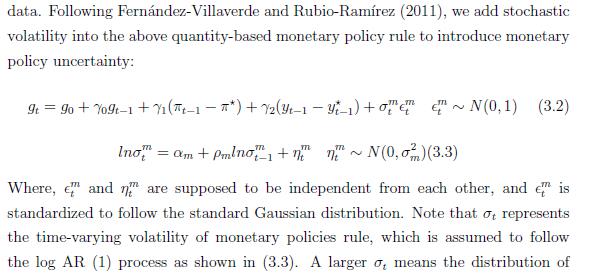Dear all
I am conducting the research for the model with stochastic volatility shock as Born and Pfeifer (2014).
I am going to use the Bayesian method with particle filter (2nd order) to obtain estimated parameters. But there are some problems with the code. when I run 1st order, the code works well but it go with some problems when I run 2nd order. I attached code for this part, please give me some advice to overcome this problem.
I try to run the code in the website: linear_model.mod
With the dynare version: 4.5.4., the code does not work and the error is:
Warning: stochastic_solvers: using order = 1 because Hessian is equal to zero
In stochastic_solvers (line 58)
In resol (line 144)
In dynare_resolve (line 69)
In non_linear_dsge_likelihood (line 228)
In initial_estimation_checks (line 137)
In dynare_estimation_1 (line 165)
In dynare_estimation (line 105)
In linear_model (line 186)
In dynare (line 223)
ESTIMATION_CHECKS: There was an error in computing the likelihood for initial parameter values.
ESTIMATION_CHECKS: If this is not a problem with the setting of options (check the error message below),
ESTIMATION_CHECKS: you should try using the calibrated version of the model as starting values. To do
ESTIMATION_CHECKS: this, add an empty estimated_params_init-block with use_calibration option immediately before the estimation
ESTIMATION_CHECKS: command (and after the estimated_params-block so that it does not get overwritten):
Reference to non-existent field ‘ghxx’.
Error in non_linear_dsge_likelihood (line 294)
ReducedForm.ghxx = dr.ghxx(restrict_variables_idx,:);
Error in initial_estimation_checks (line 137)
[fval,info] =
feval(objective_function,xparam1,DynareDataset,DatasetInfo,DynareOptions,Model,EstimatedParameters,BayesInfo,BoundsInfo,DynareResults);
Error in dynare_estimation_1 (line 165)
oo_ =
initial_estimation_checks(objective_function,xparam1,dataset_,dataset_info,M_,estim_params_,options_,bayestopt_,bounds,oo_);
Error in dynare_estimation (line 105)
dynare_estimation_1(var_list,dname);
Error in linear_model (line 186)
oo_recursive_=dynare_estimation(var_list_);
Error in dynare (line 223)
evalin(‘base’,fname) ;
For unstable version, the error is even worse
I greatly appreciate any suggestion.data_sub1.m (2.8 KB)
nonlinear_Calvo_PR_sub1.mod (10.5 KB)
